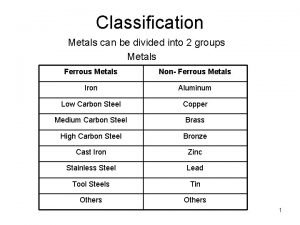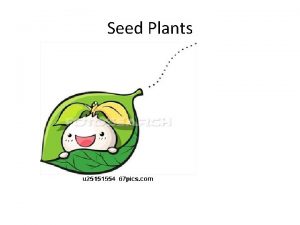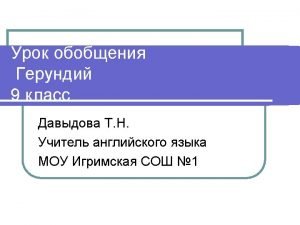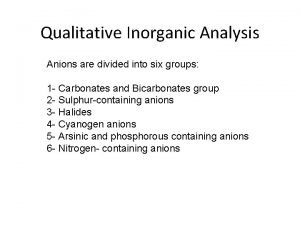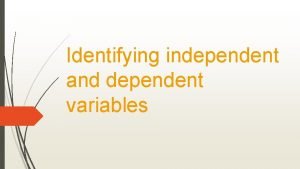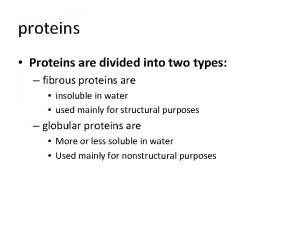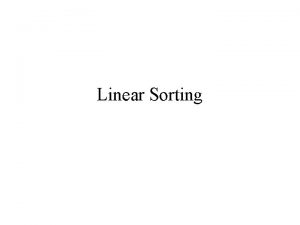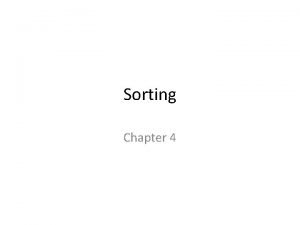Sorting Materials into Groups 1 Appearance Materials can









- Slides: 9

Sorting Materials into Groups 1

Appearance Materials can be classified on the basis of how they look or appear to be. Some materials have lustre, which is a very gentle sheen or soft glow to them while others are plain and dull looking. Materials that have such lustre can usually be classified as Metals. Examples include gold, copper, aluminium, iron etc. Usually, a metal loses its lustre after some time due to the action of moisture and air on it. Therefore only freshly-cut metals appear to have lustre on them. TOPIC/COURSE CODE-NAME/FACULTY/DEPT/COLLEGE 2/10

2. Hardness Materials can also be classified on the basis of hardness. Materials that can be easily compressed or scratched are called Soft. Materials that cannot be scratched and are difficult to compress are termed as Hard. 5/26/2020 TOPIC/COURSE CODE-NAME/FACULTY/DEPT/COLLEGE 3/10

3. Soluble or Insoluble Materials that can be dissolved in water upon stirring are said to be soluble materials. For Example, Sugar and Salt can be dissolved in water. Materials that cannot be dissolved in water no matter how much we stir them are said to be insoluble materials. For Example, Stones and Clothes cannot be dissolved in water. Not just solid materials, even liquids have the property of being soluble or insoluble. For Example, Lemon juice can easily dissolve in water while oil does not dissolve and deposits as a thin layer on the uppermost layer of water. 5/26/2020 TOPIC/COURSE CODE-NAME/FACULTY/DEPT/COLLEGE 4/10

QUESTIONS RELATED TO ABOVE SLIDES 5/26/2020 TOPIC/COURSE CODE-NAME/FACULTY/DEPT/COLLEGE 5/10

4. Objects may float or sink in water There are some insoluble objects or materials which sink to the bottom of the surface when dissolved in water while some other float on the surface of the water. For Example, leaves and corks float in water while rocks and coins sink in water. 5/26/2020 TOPIC/COURSE CODE-NAME/FACULTY/DEPT/COLLEGE 6/10

5. Transparency Objects or materials which can be seen through are said to be transparent objects. For Example, Glass, clear water and some plastics can be seen through and are hence transparent materials. Objects and materials through which things can be seen but only partially are called Translucent objects. Butter paper and frosted glass are some examples of translucent objects. Objects which cannot be seen through are known as opaque objects. For Example, Metals, wood and cardboard are some examples of opaque materials as you cannot see through them. 5/26/2020 TOPIC/COURSE CODE-NAME/FACULTY/DEPT/COLLEGE 7/10

CONTENT SLIDE 5/26/2020 TOPIC/COURSE CODE-NAME/FACULTY/DEPT/COLLEGE 8/10

Why do we need to group objects? We need to group objects for a number of reasons: Convenience to store Convenience to study 5/26/2020 TOPIC/COURSE CODE-NAME/FACULTY/DEPT/COLLEGE 9/10
 What is internal and external sorting
What is internal and external sorting Classification of ferrous metals
Classification of ferrous metals Seed plants are divided into two groups called
Seed plants are divided into two groups called How are ethnic groups and religious groups related
How are ethnic groups and religious groups related Divide the words into groups
Divide the words into groups It is the arrangement of something into different groups
It is the arrangement of something into different groups What is the brown ring in the brown ring test
What is the brown ring in the brown ring test Identifying dependent and independent variables
Identifying dependent and independent variables Proteins are divided into two groups
Proteins are divided into two groups Biology classification system
Biology classification system

